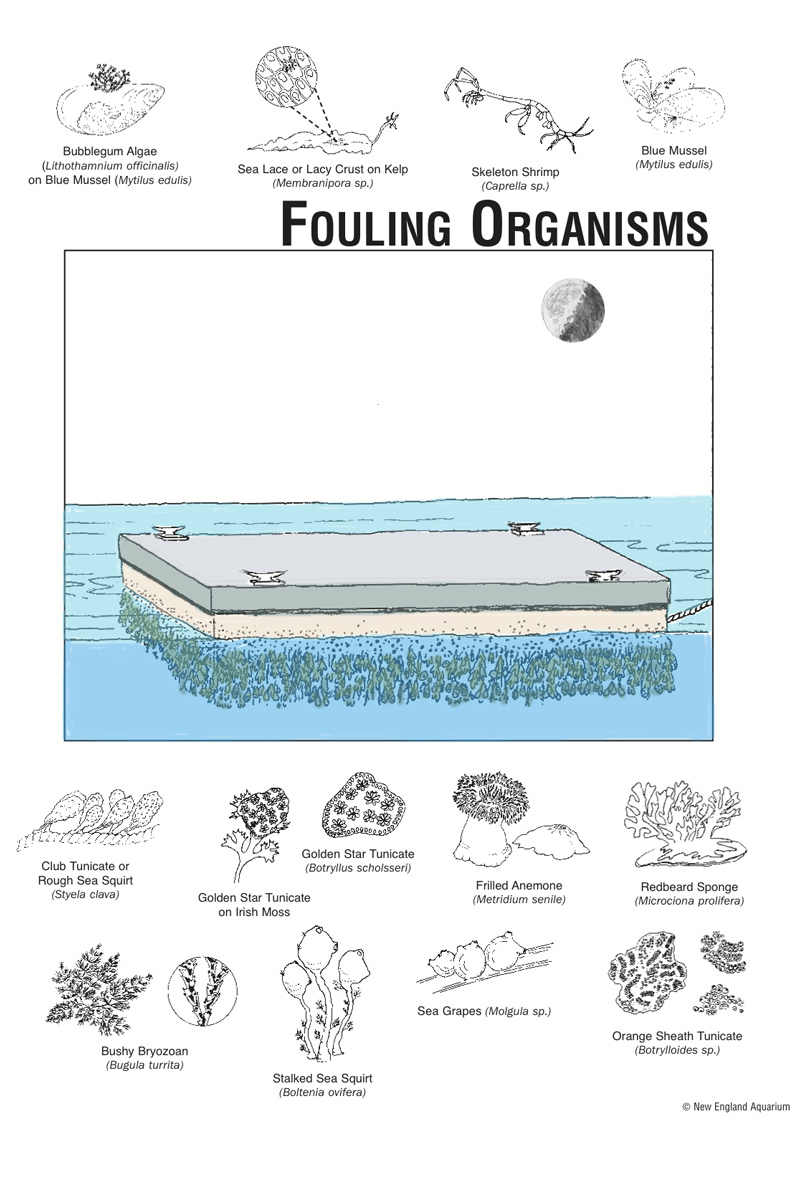Fouling Organisms
PHYSICAL CONDITIONS Floats on docks, such as those at marinas, support an amazing variety of organisms. Organisms that attach to floating objects in the ocean are called "fouling organisms." This negative term originated as a reference to the way they slow the speed of a ship when they build up on the bottom of a hull.
The obvious difference between this habitat and a rocky shore is that it is never exposed to the air. Although the tide rises and falls, these organisms never face the problem of desiccation. They do, however, face changes in salinity. Most marinas are in estuaries. These river mouths are frequently flooded with fresh water. The organisms living here must be able to withstand at least short exposure to reduced salinity during rain storms. Sea water in New England averages a salinity of about 32 parts per thousand (ppt). In estuaries, salinity is often much lower and in flood conditions may reach 0 ppt.
Floats provide a solid substrate to which animals and algae attach. Since this zone is rarely disturbed by natural forces apart from ice, a highly diverse yet stable community forms. Another physical characteristic of this zone is the wide temperature variations it experiences through the year. The organisms that live here must tolerate temperatures that range from 23o Celsius or more in the summer to winter ice conditions with the temperature reaching -1.9o Celsius, the temperature at which sea water freezes. The community may then be subjected to the grinding and scouring of sea ice as it moves.
These organisms are also subject to pollution. Oil spills from fueling operations, bilge discharge and highway runoff all contribute to the floating chemical pollution of this habitat. Serious spills of lightweight hydrocarbons (like gasoline and fuel oils) may wipe out the communities on floats near the source of the spill. Add to this the chemical poisons leaching from antifouling paints used on boat hulls and the chemical load in the water may limit the development of a vigorous community.
CHARACTERISTICS OF LIFE Since the substrate is solid, animals and algae with the capability of attaching to a solid surface settle on the floats. Diatoms, green alga and red algae often settle first, forming a pale green film on the floats. Then come the larger green algae such as Enteromorpha, a long green tube-like algae, Ulva, known as sea lettuce, and Chladophora, a tangled mass of green filaments. Along with the green algae, both red and brown algae find a home here. With the exception of rock weed, either Fucus or Ascophyllum, these do not have common names. Each of these algae has a holdfast, a structure that attaches the organism to the float.
Along with the algae a host of animals settle here. Juvenile barnacles settle in May and June, often forming solid banks of tiny volcano-shaped tests. Blue mussels (Mytilus edulus), attached by byssal threads, often form thick beds that appear to shut out all other organisms. In these beds you may find a strange creature called a sea squirt or sea grape (Molgula sp.), one of several tunicates that grow well on floats. Sea grapes resemble small pale white grapes with two siphon openings. When handled roughly they contract, squirting out the water they contain, hence the name sea squirt. A long wrinkled club-shaped tunicate (Styela sp.) is also common here. It resembles an elongate prune, again with two siphon openings on top. These are the solitary tunicates. There are also colonial or social tunicates, like the star tunicate (Botryllus schlosseri). Star tunicates form thin flat colonies that appears to have star-shaped arrangements of individuals in a common matrix or tunic.
As summer begins, the community changes as various algae and animals reach their maximum growth. Among these is a bright pink hydrozoan (Tubularia crocea), which looks like a bunch of small pink flowers. Other hydrozoans found in summer include the squirrel tail hydrozoan (Sertularia pumila) and Companularia sp. Examine these with a hand lens and you will see tiny individuals resembling sea anemones. Encrusting the algae you may find Obelia, a hydrozoan used in biology classes as an example of the typical hydrozoan.
Sponges are common on floats. Nearly all of these are small and encrusting. They help glue the community together. Most are beige or yellow-colored. An exception is the red beard or fire sponge (Microciona prolifera). Handle this one with care since it can cause a burning irritation.
A number of animals live among the attached organisms. Numerous worms of the polychaete class crawl among the mussels and algae. Examine the algae carefully and you may get a glimpse of sea spiders, class pycnogonida, and strange little skeleton shrimp (Caprella sp.) Sliding across the algae you will find sea slugs, called nudibranchs because they have naked gills. Some of these feed on hydrozoans and recycle the stinging cells for their own defense. They can be recognized by the frilly gills on their backs. Examine the algae carefully and you will find many algae growing on other algae. These are called epiphytes since they use another algae as a substrate on which to grow. They are not parasites, but only use their host as a home.
(Adobe PDF)
The above text is adapted from New England Aquarium's Boston Harbor Seaside Educator's Guide
(illustrations after Cindy Lydon - NEAQ Boston Harbor Seaside Educator's Guide)
